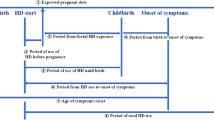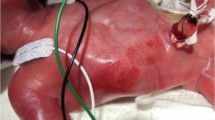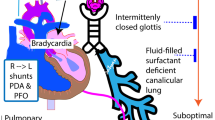Abstract
As neonatal care has advanced and more immature infants are admitted to the neonatal intensive care unit, we must reevaluate fundamental management practices originally developed for infants born at later gestational ages. Studies have investigated the use of various incubator humidification levels in the care of preterm infants of older gestational ages, but evidence regarding management of ambient humidity for infants born at <25 weeks’ gestation using contemporary technology is limited. Uncertainty about the best approach to incubator humidification is reflected in major variation in practice around the world. This article summarizes existing evidence about the use of humidity in incubators and its relationship with neonatal skin maturation, fluid management, temperature regulation, and morbidities. It also describes approaches to starting humidification, duration of humidification, and reducing humidification over time. It concludes with a list of important questions requiring future research.
This is a preview of subscription content, access via your institution
Access options
Subscribe to this journal
Receive 12 print issues and online access
$259.00 per year
only $21.58 per issue
Buy this article
- Purchase on SpringerLink
- Instant access to full article PDF
Prices may be subject to local taxes which are calculated during checkout

Similar content being viewed by others
References
Baker JP. The incubator and the medical discovery of the premature infant. J Perinatol. 2000;20:321–8.
Silverman WA, Fertig JW, Berger AP. The influence of the thermal environment upon the survival of newly born premature infants. Pediatrics 1958;22:876–86.
Silverman WA, Blanc WA. The effect of humidity on survival of newly born premature infants. Pediatrics 1957;20:477–86.
Silverman WA, Agate FJ Jr, Fertig JW. A sequential trial of the nonthermal effect of atmospheric humidity on survival of newborn infants of low birth weight. Pediatrics 1963;31:719–24.
Silverman WA. Diagnosis and treatment: use and misuse of the temperature and humidity in care of the newborn infant. Pediatrics 1964;33:276–7.
Silverman WA. Risks of premature existence in hospital humidity and temperature. Bull Acad Med NJ. 1962;8:159–61.
Rysavy MA, Bennett MM, Ahmad KA, Patel RM, Shah ZS, Ellsbury DL, et al. Neonatal intensive care unit resource use for infants at 22 weeks’ gestation in the US, 2008-2021. JAMA Netw Open. 2024;7:e240124.
Lynam LE, Biagotti L. Testing for bacterial colonization in an Ohmeda Medical Giraffe humidification system. Neonatal Intensive Care. 2002;15:50–4.
Kong YS, Medhurst A, Cheong JLY, Kotsanas D, Jolley D. The effect of incubator humidity on the body temperature of infants born at 28 weeks’ gestation or less: A randomized controlled trial. Neonatal. Paediatr Child Health Nurs. 2011;14:14–22.
American Academy of Pediatrics and College of Obstetrics and Gynecologists. Guidelines for Perinatal Care. Elk Grove Village, IL: 2012.
Moniaci VK, Bellflower B. NANN’s Thermoregulation in the care of infants guideline for practice executive summary. Adv Neonatal Care. 2021;21:340.
Brandon D, Hill CM, Heimall L, Lund CH, Kuller J, McEwan T, et al. Neonatal Skin Care: Evidence-Based Clinical Practice Guideline. 4th ed. Washington D.C., Association of Women's Health, Obstetric and Neonatal Nurses, 2018.
Glass L, Valdez A. Preterm infant incubator humidity levels: a systematic review. Adv Neonatal Care. 2021;21:297–307.
Tiny Baby Collaborative: International Research Group. Accessed at: www.tinybabycollaborative.org Accessed on March, 2025.
National Institute of Child Health and Human Development: Neonatal Research Network, National Institutes of Health. Research Triangle Institute International. Accessed at: https://neonatal.rti.org Accessed on March, 2025.
Dagle JM, Rysavy MA, Hunter SK, Colaizy TT, Elgin TG, Giesinger RE, et al. Cardiorespiratory management of infants born at 22 weeks’ gestation: the Iowa approach. Semin Perinatol. 2022;46:1515–45.
Sinclair L, Crisp J, Sinn J. Variability in incubator humidity practices in the management of Preterm Infants. J Paediatr Child Health. 2009;45:535–40.
Deguines C, Décima P, Pelletier A, Dégrugilliers L, Ghyselen L, Tourneux P. Variations in incubator temperature and humidity management: A survey of current practice. Acta Paediatrica. 2011;101:230–5.
Jani P, Mishra U, Buchmayer J, Walker K, Gözen D, Maheshwari R, et al. Thermoregulation and golden hour practices in extremely preterm infants: an international survey. Pediatr Res. 2023;93:1701–1709.
Roychoudhury S, Yusuf K. Thermoregulation: advances in preterm infants. NeoReviews. 2017;18:e692–700.
Knobel R, Holditch‐Davis D. Thermoregulation and heat loss prevention after birth and during neonatal intensive‐care unit stabilization of extremely low‐birthweight infants. Adv Neonatal Care. 2010;10:S7–14.
Hammarlund K, Sedin G. Transepidermal water loss in newborn infants. VI. Heat exchange with the environment in relation to gestational age. Acta Paediatr Scand. 1982;71:191–6.
Ågren J, Sjörs G, Sedin G. Ambient humidity influences the rate of skin barrier maturation in extremely preterm infants. J Pediatr. 2006;148:613–7.
Sedin G, Agren J. Water and heat-the priority for the newborn infant. Ups J Med Sci. 2006;111:45–59.
Sung SI, Ahn SY, Seo HJ, Yoo HS, Han YM, Lee MS, et al. Insensible water loss during the first week of life of extremely low birth weight infants less than 25 gestational weeks under high humidification. Neonatal Med. 2013;20:51–7.
Kurimoto T, Ibara S, Ishihara C, Naito Y, Hirakawa E, Yamamoto T. Incubator humidity and temperature control in infants born at 22–23 weeks’ gestation. Early Hum Dev. 2022;166:105550.
Bell EF, Acarregui MJ. Restricted versus liberal water intake for preventing morbidity and mortality in preterm infants. Cochrane Database Syst Rev. 2014;12:503.
Visscher M, Narendran V. The ontogeny of skin. Adv Wound Care. 2014;3:291–303.
Reed RC, Johnson DE, Nie AM. Preterm infant skin structure is qualitatively and quantitatively different from that of term newborns. Pediatr Dev Pathol. 2021;24:96–102.
Johnson DE. Extremely preterm infant skin care: a transformation of practice aimed to prevent harm. Adv Neonatal Care. 2016;5:26–32.
Kanti V, Bonzel A, Stroux A, Proquitté H, Bührer C, Blume-Peytavi U, et al. Postnatal maturation of skin barrier function in premature infants. Ski Pharm Physiol. 2014;27:234–241.
Hoffman MA, Finberg L. Pseudomonas infections in infants associated with high-humidity environments. J Pediatr. 1955;46:626–30.
Moffet HL, David A, Williams T. Survival and dissemination of bacteria in nebulizers and incubators. Am J Dis Child. 1967;114:13–20.
Horbar JD, Edwards EM, Greenberg LT, Morrow KA, Soll RF, Buus-Frank ME, et al. Variation in performance of neonatal intensive care units in the United States. JAMA Pediatr. 2017;171:e164396.
Jonckers T, Ruhe K, Giezen A, Van den Hoogen A, Wielenga J. Humidification of incubator air for premature infants: An empty systematic review. J Neonatal Nurs. 2025;31:1–5.
Noreiks G, August D, Lai M, Davies M. Ceasing or gradually reducing incubator humidity after 7 days for extremely preterm infants: a randomized clinical trial. Eur J Pediatr. 2024;184:66.
Silverman WA. Overtreatment of neonates? A personal retrospective. Pediatrics. 1992;90:971–6.
Author information
Authors and Affiliations
Consortia
Contributions
CS and MR conceptualized the article and wrote the first draft. PJ, JA, EB, DA, and CB contributed content expertise and made critical revisions. Members of the Tiny Baby Collaborative Steering Committee helped with content development and editing of the manuscript. All authors approved the final manuscript and agree to be accountable for all aspects of the work.
Corresponding author
Ethics declarations
Competing interests
The authors declare no competing interests.
Additional information
Publisher’s note Springer Nature remains neutral with regard to jurisdictional claims in published maps and institutional affiliations.
Rights and permissions
Springer Nature or its licensor (e.g. a society or other partner) holds exclusive rights to this article under a publishing agreement with the author(s) or other rightsholder(s); author self-archiving of the accepted manuscript version of this article is solely governed by the terms of such publishing agreement and applicable law.
About this article
Cite this article
Stoll, C.M., Jani, P.R., Ågren, J. et al. Approaches to incubator humidification at <25 weeks’ gestation and potential impacts on infants. J Perinatol (2025). https://doi.org/10.1038/s41372-025-02294-1
Received:
Revised:
Accepted:
Published:
DOI: https://doi.org/10.1038/s41372-025-02294-1



